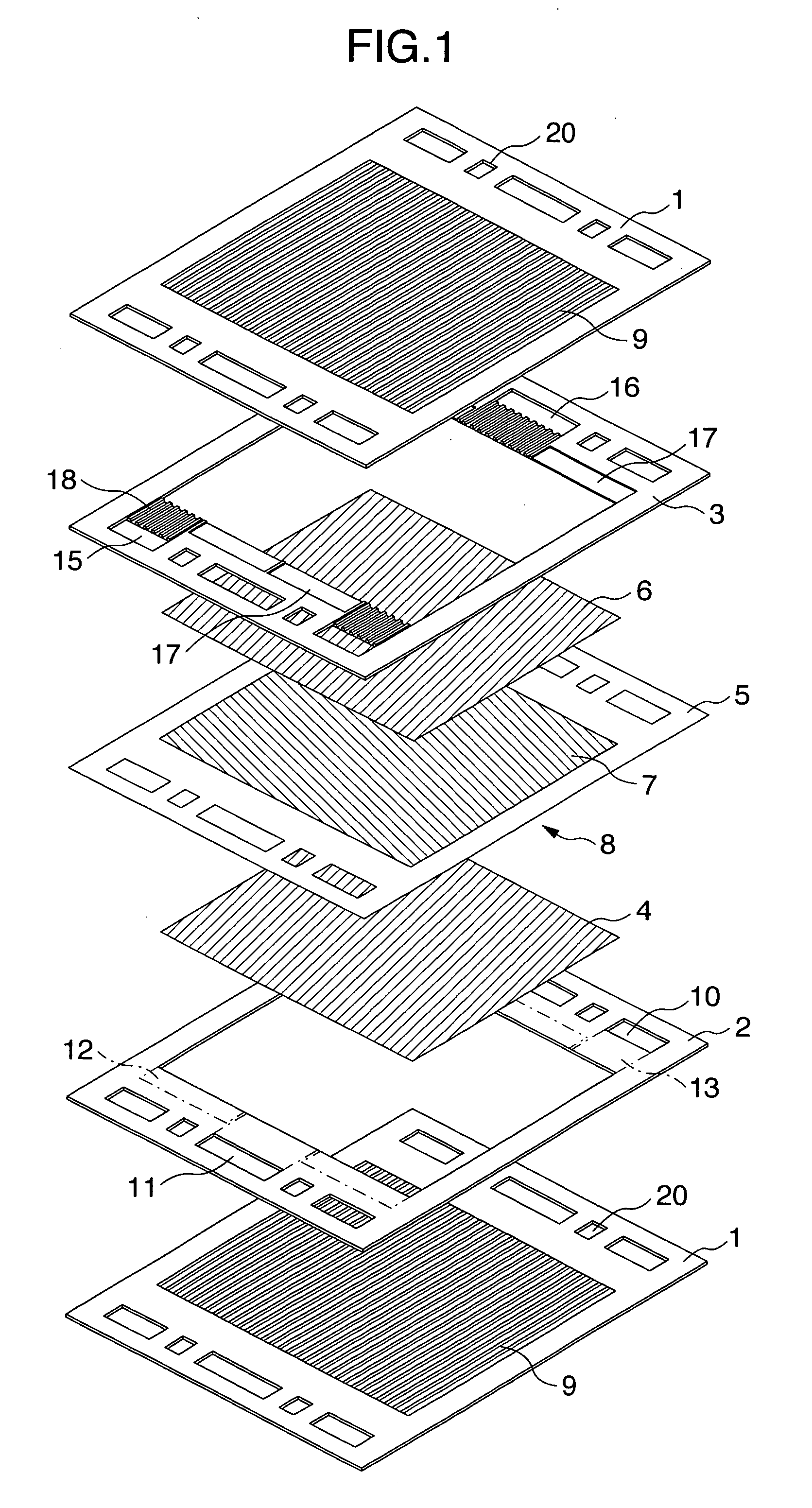Solid polymer type fuel cell, metal separator for fuel cell, and kit for fuel cell
- Summary
- Abstract
- Description
- Claims
- Application Information
AI Technical Summary
Benefits of technology
Problems solved by technology
Method used
Image
Examples
example 1
[0079] A 0.15 mm-thick stainless steel sheet having press-molded thereon 31 linear ridge / groove-shaped gas channels which had a gas channel pitch of 3 mm and an overhang of 0.3 mm was made to serve as a metal gas channel plate 1. On a 0.5 mm-thick sheet of PPS (polyphenylenesulfide) in which portions corresponding to the linear gas channels were in a hollowed out frame-shape, a cathode-side frame 2 was formed comprising a cathode gas supply manifold aperture 10, a cathode gas discharge manifold aperture 11, an anode gas supply manifold aperture 15, an anode gas discharge manifold aperture 16, a cathode turn-around portion 12, and three each of gas distribution channels A31 and distribution channels B32 for a total of 6 channels. The metal gas channel plate 1 and the frame 2 were adhered together using a liquid-state gasket so that there were no gaps therebetween, to thereby fabricate a cathode separator.
[0080] An external view of the cathode separator is illustrated in FIG. 2. In t...
example 2
[0086] A cathode-side frame 2 was formed comprising a cathode gas supply manifold aperture 10, a cathode gas discharge manifold aperture 11, an anode gas supply manifold aperture 15, an anode gas discharge manifold aperture 16, a cathode turn-around portion 12, and two each of gas distribution channels A31 and distribution channels B32 for a total of 4 channels. A metal gas channel plate 1 having linear ridge / groove-shaped gas channels 9 and the frame 2 were adhered together using a liquid-state gasket so that there were no gaps therebetween, to thereby fabricate a cathode separator. An external view of the cathode separator is illustrated in FIG. 3.
[0087] In this cathode separator, there are two gas distribution channels, gas distribution channel A31 and distribution channel B32, formed by the linear ridge / groove-shaped gas channels through which gas flows in the supply manifold, the discharge manifold and therebetween. Since each of the distribution channels 31 and 32 has 2 turn-...
example 3
[0088] A cathode-side frame 2 was formed comprising a cathode gas supply manifold aperture 10, a cathode gas discharge manifold aperture 11, an anode gas supply manifold aperture 15, an anode gas discharge manifold aperture 16, a cathode turn-around portion 12, and two each of gas distribution channels A31 and distribution channels B32 for a total of 4 channels. A metal gas channel plate 1 having linear ridge / groove-shaped gas channels 9 and the frame 2 were adhered together using a liquid-state gasket so that there were no gaps therebetween, to thereby fabricate a cathode separator. An external view of the cathode separator is illustrated in FIG. 4.
[0089] In this cathode separator, there are two gas distribution channels, gas distribution channel A31 and distribution channel B32, formed by the linear ridge / groove-shaped gas channels through which gas flows in the supply manifold, the discharge manifold and therebetween. Since each of the distribution channels 31 and 32 has 2 turn-...
PUM
 Login to View More
Login to View More Abstract
Description
Claims
Application Information
 Login to View More
Login to View More - R&D
- Intellectual Property
- Life Sciences
- Materials
- Tech Scout
- Unparalleled Data Quality
- Higher Quality Content
- 60% Fewer Hallucinations
Browse by: Latest US Patents, China's latest patents, Technical Efficacy Thesaurus, Application Domain, Technology Topic, Popular Technical Reports.
© 2025 PatSnap. All rights reserved.Legal|Privacy policy|Modern Slavery Act Transparency Statement|Sitemap|About US| Contact US: help@patsnap.com



